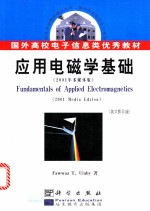图书介绍
应用电磁学基础 2001年多媒体版 英文本PDF|Epub|txt|kindle电子书版本网盘下载

- Fawwaz T.Ulaby著 著
- 出版社: 北京:科学出版社
- ISBN:7030106040
- 出版时间:2002
- 标注页数:433页
- 文件大小:48MB
- 文件页数:451页
- 主题词:电磁学(学科: 高等学校) 电磁学
PDF下载
下载说明
应用电磁学基础 2001年多媒体版 英文本PDF格式电子书版下载
下载的文件为RAR压缩包。需要使用解压软件进行解压得到PDF格式图书。建议使用BT下载工具Free Download Manager进行下载,简称FDM(免费,没有广告,支持多平台)。本站资源全部打包为BT种子。所以需要使用专业的BT下载软件进行下载。如BitComet qBittorrent uTorrent等BT下载工具。迅雷目前由于本站不是热门资源。不推荐使用!后期资源热门了。安装了迅雷也可以迅雷进行下载!
(文件页数 要大于 标注页数,上中下等多册电子书除外)
注意:本站所有压缩包均有解压码: 点击下载压缩包解压工具
图书目录
1 INTRODUCTION:WAVES AND PHASORS1
1-1 Dimensions,Units,and Notation4
1-2 The Nature of Electromagnetism5
1-2.1 The Gravitational Force:A Useful Analogue6
1-2.2 Electric Fields7
1-2.3 Magnetic Fields9
1-2.4 Static and Dynamic Fields11
1-3 Traveling Waves12
1-3.1 Sinusoidal Wave in a Lossless Medium14
1-3.2 Sinusoidal Wave in a Lossy Medium17
1-4 The Electromagnetic Spectrum19
1-5 Review of Complex Numbers22
1-6 Review of Phasors24
Problems29
2 TRANSMISSION LINES33
2-1 General Considerations35
2-1.1 The Role of Wavelength36
2-1.2 Propagation Modes37
2-2 Lumped-Element Model39
2-3 Transmission-Line Equations43
2-4 Wave Propagation on a Transmission Line44
2-5 The Lossless Transmission Line47
2-5.1 Voltage Reflection Coefficient48
2-5.2 Standing Waves51
2-6 Input Impedance of the Lossless Line55
2-7.1 Short-Circuited Line58
2-7 Special Cases of the Lossless Line58
2-7.2 Open-Circuited Line60
2-7.3 Application of Short-Circuit and Open-Circuit Measurements60
2-7.4 Lines of Length ι=nλ/262
2-7.5 Quarter-Wave Transformer62
2-7.6 Matched Transmission Line:Z8L=Z062
2-8 Power Flow on a Lossless Transmission Line64
2-8.1 Instantaneous Power64
2-8.2 Time-Average Power65
2-9 The Smith Chart66
2-9.1 Parametric Equations66
2-9.2 Input Impedance71
2-9.3 SWR,Voltage Maxima and Minima73
2-9.4 Impedance to Admittance Transformations74
2-10 Impedance Matching80
2-11 Transients on Transmission Lines84
2-11.1 Transient Response84
2-11.2 Bounce Diagrams88
Problems92
3 VECTOR ANALYSIS100
3-1 Basic Laws of Vector Algebra101
3-1.1 Equality of Two Vectors102
3-1.2 Vector Addition and Subtraction103
3-1.3 Position and Distance Vectors103
3-1.4 Vector Multiplication104
3-1.5 Scalar and Vector Triple Products107
3-2 Orthogonal Coordinate Systems108
3-2.2 Cylindrical Coordinates109
3-2.1 Cartesian Coordinates109
3-2.3 Spherical Coordinates113
3-3 Transformations between Coordinate Systems115
3-3.1 Cartesian to Cylindrical Transformations115
3-3.2 Cartesian to Spherical Transformations117
3-3.3 Cylindrical to Spherical Transformations119
3-3.4 Distance between Two Points119
3-4 Gradient of a Scalar Field120
3-4.1 Gradient Operator in Cylindrical and Spherical Coordinates121
3-4.2 Properties of the Gradient Operator122
3-5 Divergence of a Vector Field123
3-5.1 Divergence Theorem125
3-5.2 Remarks on Notation125
3-6 Curl of a Vector Field127
3-6.1 Vector Identities Involving the Curl128
3-6.2 Stokes's Theorem129
3-7 Laplacian Operator130
Problems132
4 ELECTROSTATICS138
4-1 Maxwell's Equations139
4-2 Charge and Current Distributions140
4-2.1 Charge Densities140
4-2.2 Current Density142
4-3 Coulomb's Law143
4-3.1 Electric Field due to Multiple Point Charges144
4-3.2 Electric Field due to a Charge Distribution145
4-5.4 Electric Field as a Function of Electric Potential147
4-4 Gauss's Law148
4-5 Electric Scalar Potential151
4-5.1 Electric Potential as a Function of Electric Field151
4-5.2 Electric Potential due to Point Charges153
4-5.3 Electric Potential due to Continuous Distributions153
4-5.5 Poisson's Equation155
4-6 Electrical Properties of Materials156
4-7 Conductors157
4-7.1 Resistance158
4-7.2 Joule's Law160
4-8 Dielectrics161
4-9 Electric Boundary Conditions163
4-9.1 Dielectric—Conductor Boundary166
4-9.2 Conductor—Conductor Boundary167
4-10 Capacitance168
4-11 Electrostatic Potential Energy172
4-12 Image Method173
Problems176
5 MAGNETOSTATICS186
5-1 Magnetic Forces and Torques187
5-1.1 Magnetic Force on a Current-Carrying Conductor189
5-1.2 Magnetic Torque on a Current-Carrying Loop192
5-2 The Biot—Savart Law195
5-2.1 Magnetic Field due to Surface and Volume Current Distributions196
5-2.2 Magnetic Field of a Magnetic Dipole199
5-3 Magnetic Force between Two Parallel Conductors200
5-4 Maxwell's Magnetostatic Equations201
5-4.1 Gauss's Law for Magnetism201
5-4.2 Amphere's Law202
5-5 Vector Magnetic Potential206
5-6 Magnetic Properties of Materials208
5-6.1 Orbital and Spin Magnetic Moments208
5-6.2 Magnetic Permeability209
5-6.3 Magnetic Hysteresis of Ferromagnetic Materials210
5-7 Magnetic Boundary Conditions213
5-8 Inductance214
5-8.1 Magnetic Field in a Solenoid215
5-8.2 Self-inductance216
5-8.3 Mutual Inductance218
5-9 Magnetic Energy219
Problems221
6 MAXWELL'S EQUATIONS FOR TIME-VARYING FIELDS229
6-1 Faraday's Law231
6-2 Stationary Loop in a Time-Varying Magnetic Field233
6-3 The Ideal Transformer237
6-4 Moving Conductor in a Static Magnetic Field238
6-5 The Electromagnetic Generator241
6-6 Moving Conductor in a Time-Varying Magnetic Field243
6-7 Displacement Current244
6-8 Boundary Conditions for Electromagnetics246
6-9 Charge-Current Continuity Relation247
6-10 Free-Charge Dissipation in a Conductor249
6-11 Electromagnetic Potentials250
6-11.1 Retarded Potentials250
6-11.2 Time-Harmonic Potentials251
Problems255
7 PLANE-WAVE PROPAGATION260
7-1 Time-Harmonic Fields262
7-1.1 Complex Permittivity263
7-1.2 Wave Equations for a Charge-Free Medium263
7-2 Plane-Wave Propagation in Lossless Media264
7-2.1 Uniform Plane Waves264
7-2.2 General Relation between E and H268
7-3 Wave Polarization269
7-3.1 Linear Polarization270
7-3.2 Circular Polarization271
7-3.3 Elliptical Polarization273
7-4 Plane-Wave Propagation in Lossy Media276
7-4.1 Low-Loss Dielectric278
7-4.2 Good Conductor278
7-5 Current Flow in a Good Conductor280
7-6 Electromagnetic Power Density283
7-6.1 Plane Wave in a Lossless Medium284
7-6.2 Plane Wave in a Lossy Medium285
7-6.3 Decibel Scale for Power Ratios286
Problems288
8 WAVE REFLECTION AND TRANSMISSION,AND GEOMETRIC OPTICS292
8-1 Wave Reflection and Transmission at Normal Incidence294
8-1.1 Boundary between Lossless Media294
8-1.2 Transmission-Line Analogue297
8-1.3 Power Flow in Lossless Media298
8-1.4 Boundary between Lossy Media301
8-2 Snell's Laws303
8-3 Fiber Optics306
8-4 Wave Reflection and Transmission at Oblique Incidence308
8-4.1 Perpendicular Polarization309
8-4.2 Parallel Polarization313
8-4.3 Brewster Angle315
8-5 Reflectivity and Transmissivity316
8-6 Geometric Optics319
8-7 Images Formed by Mirrors320
8-7.1 Images Formed by Plane Mirrors321
8-7.2 Images Formed by Spherical Mirrors322
8-8 Images Formed by Spherical Lenses324
Problems332
9 RADIATION AND ANTENNAS340
9-1 The Short Dipole343
9-1.1 Far-Field Approximation345
9-1.2 Power Density346
9-2 Antenna Radiation Characteristics348
9-2.1 Antenna Pattern349
9-2.2 Beam Dimensions351
9-2.3 Antenna Directivity351
9-2.4 Antenna Gain354
9-2.5 Radiation Resistance354
9-3 Half-Wave Dipole Antenna355
9-3.1 Directivity of λ/2 Dipole357
9-3.2 Radiation Resistance of λ/2 Dipole357
9-3.3 Quarter-Wave Monopole Antenna358
9-4 Dipole of Arbitrary Length359
9-5 Effective Area of a Receiving Antenna360
9-6 Friis Transmission Formula363
9-7 Radiation by Large-Aperture Antennas365
9-8 Rectangular Aperture with Uniform Aperture Distribution368
9-8.1 Beamwidth369
9-8.2 Directivity and Effective Area370
9-9 Antenna Arrays371
9-10 N-Element Array with Uniform Phase Distribution378
9-11 Electronic Scanning of Arrays380
9-11.1 Uniform-Amplitude Excitation382
9-11.2 Array Feeding382
Problems386
10 SATELLITE COMMUNICATION SYSTEMS AND RADAR SENSORS390
10-1 Satellite Communication Systems391
10-2 Satellite Transponders393
10-3 Communication-Link Power Budget396
10-4 Antenna Beams398
10-5.1 Basic Operation of a Radar System399
10-5 Radar Sensors399
10-5.2 Unambiguous Range400
10-5.3 Range and Angular Resolutions401
10-6 Target Detection402
10-7 Doppler Radar404
10-8 Monopulse Radar406
Problems410
APPENDIX A SYMBOLS,QUANTITIES,AND UNITS411
APPENDIX B MATERIAL CONSTANTS OF SOME COMMON MATERIALS413
APPENDIX C MATHEMATICAL FORMULAS415
APPENDIX D ANSWERS TO ODD-NUMBERED PROBLEMS417
BIBLIOGRAPHY423
INDEX425